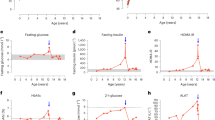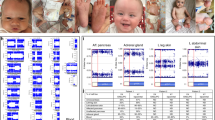Abstract
Overexpression of the normally imprinted fetal insulin–like growth factor II (IGF2) has been implicated in the pathogenesis of the cancer–predisposing Beckwith–Wiedemann syndrome (BWS). We have detected constitutional relaxation of imprinting of IGF2 in four children with somatic overgrowth who do not show diagnostic features of BWS. Three children showed constitutional abnormalities of H19 methylation. All four children showed nephromegaly and two developed Wilms' tumors. Gene methylation is known to be associated with gene silencing, and three children showed constitutional abnormalities of HI9 gene methylation. Disruption of H19 methylation, and concomitant relaxation of IGF2 imprinting, provides another mechanism that can increase IGF2 expression in children with overgrowth. The accumulated data on normal and pathologic IGF2 expression are now sufficient to define an entity, “IGF2 overgrowth disorder,” of which BWS may be one extreme manifestation. These findings have broad implications for the characterization of idiopathic overgrowth.
This is a preview of subscription content, access via your institution
Access options
Subscribe to this journal
Receive 12 print issues and online access
$209.00 per year
only $17.42 per issue
Buy this article
- Purchase on Springer Link
- Instant access to full article PDF
Prices may be subject to local taxes which are calculated during checkout
Similar content being viewed by others
References
Leighton, P.A., Ingram, R.S., Eggenschwiler, J., Efstratiadis, A. & Tilghman, S.M. Disruption of imprinting caused by deletion of the H19 gene region in mice. Nature 375, 34–39 (1995).
DeChiara, T.M., Efstradiadis, A. & Robertson, E.J. A growth-deficiency phenotype in heterozygous mice carrying an insulin-like growth factor II gene disrupted by targeting. Nature 345, 78–80 (1990).
Hedborg, F., Holmgren, L., Sandstedt, B. & Ohlsson, R. The cell type-specific IGF2 expression during early human development correlates to the pattern of overgrowth and neoplasia in the Beckwith-Wiedemann syndrome. Am. J. Pathol. 145, 802–817 (1994).
Reeve, A.E., Eccles, M.R., Wilkins, R.J.W., Bell, G.I. & Millow, L.J. Expression of insulin-like growth factor-II transcripts in Wilms' tumour. Nature 317, 258–260 (1985).
Scott, J. et al. Insulin-like growth factor-II gene expression in Wilms' tumour and embryonic tissues. Nature 317, 261–262 (1985).
Rainier, S. et al. Relaxation of imprinted genes in human cancer. Nature 362, 747–749 (1993).
Ogawa, O. et al. Relaxation of insulin-like growth factor II gene imprinting implicated in Wilms' tumour. Nature 362, 749–751 (1993).
Zhan, S., Shapiro, D.N. & Helman, L.J. Activation of an imprinted allele of the insulin-like growth factor II gene implicated in rhabdomyosarcoma. J. Clin. Invest. 94, 445–448 (1994).
Pedone, P.V. et al. Mono- and bi-allelic expression of insulin-like growth factor II gene in human muscle tumors. Hum. Mol. Genet. 3, 1117–1121 (1994).
Weksberg, R., Shem, D.R., Song, Q.L. & Squire, J. Disruption of insulin-like growth factor 2 imprinting in Beckwith-Wiedemann syndrome. Nature Genet. 5, 143–149 (1993).
Slatter, R.E. et al. Mosaic uniparental disomy in Beckwith-Wiedemann syndrome. J. Med. Genet. 31, 749–753 (1994).
Beckwith, J.B., roglossia, omphalocele, adrenal cytomegaly, gigantism, and hyperplastic visceromegaly. Birth Defects 5, 188–196 (1969).
Wiedemann, H.-R. Tumours and hemihypertrophy associated with Wiedemann-Beckwith syndrome. Eur. J. Pediatr. 141, 129 (1983).
Pettenati, M.J. et al. Wiedemann-Beckwith syndrome: Presentation of clinical and cytogenetic data on 22 new cases and review of the literature. Hum. Genet. 74, 143–154 (1986).
Brice, A.L., Cheetham, J.E., Bolton, V.N., Hill, N.C.W. & Schofield, P.N. Temporal changes in the expression of the insulin-like growth factor II gene associated with tissue maturation in the human fetus. Development 106, 543–554 (1989).
Han, V.K.M., Lund, P.K., Lee, D.C. & DéErcole, A.J. Expression of somatomedin/insulin-like growth factor messenger ribonucleic acids in the human fetus: Identification, characterization, and tissue distribution. J. Clin. Endocrinol Metab. 66, 422–429 (1988).
Henry, I. et al. Somatic mosaicism for partial paternal isodisomy in Wiedemann-Beckwith syndrome: A post-fertilisation event. Eur. J. Hum. Genet. 1, 19–29 (1993).
Brown, K.W. et al. Paternal origin of llp15 duplications in the Beckwith-Wiedemann syndrome. Cancer Genet. Cytogenet. 58, 66–70 (1992).
Grundy, P. et al. Chromosome 11 uniparental isodisomy predisposing to embryonal neoplasms. Lancet 338, 1079–1080 (1991).
Mannens, M. et al. Parental imprinting of human chromosome region lip 15.3-pter involved in the Beckwith-Wiedemann syndrome and various human neoplasia. Eur. J. Hum. Genet. 2, 3–23 (1994).
Matsumoto, T. et al. Molecular analysis of a patient with Beckwith-Wiedemann syndrome, rhabdomyosarcoma and renal cell carcinoma. Jpn. J. Hum. Genet. 39, 225–234 (1994).
Steenman, M.J.C. et al. Loss of imprinting of IGF2 is linked to reduced expression and abnormal methylation of H19 in Wilms' tumour. Nature Genet. 7, 433–439 (1994).
Moulton, T. et al. Epigenetic lesions at the H19 locus in Wilms' tumour patients. Nature Genet. 7, 440–447 (1994).
Taniguchi, T., Sullivan, M.J., Ogawa, O. & Reeve, A.E. Epigenetic changes encompassing the IGF2/H19 locus associated with relaxation of IGF2 imprinting and silencing of H19 in Wilms tumor. Proc. Natl. Acad. Sci. USA 92, 2159–2163 (1995).
Ogawa, O. et al. Constitutional relaxation of insulin-like growth factor II gene imprinting associated with Wilms' tumour and gigantism. Nature Genet. 5, 408–412 (1993).
Han, B.K. & Babcock, D.S. Sonographic measurements and appearance of normal kidneys in children. AJR 145, 611–616 (1985).
Dittrich, B. et al. Molecular diagnosis of the Prader-Willi and Angelman syndromesbydetectionof parent-of-origin specificDNAmethylationin 15qll-13. Hum. Genet. 90, 313–315 (1992).
Tadokoro, K., Fujii, H., Inoue, T. & Yamada, M. Polymerase chain reaction (PCR) for detection of Apal polymorphism at the insulin like growth factor II gene (IGF2). Nucleic Adds Res. 19, 6967 (1991).
Gloudemans, T. et al. An Avall restriction fragment length polymorphism in the insulin-like growth factor II gene and the occurrence of smooth muscle tumors. Cancer Res. 53, 5754–5758 (1993).
Reik, W. et al. Allelic methylation of H19 and IGF2 in the Beckwith-Wiedemann syndrome. Hum. Mol. Genet. 3, 1297–1301 (1994).
Edwards, A., Civitello, A., Hammond, H.A. & Caskey, C.T. DNA typing and genetic mapping with trimeric and tetrameric tandem repeats. Am. J. Hum. Genet. 49, 746–756 (1991).
Beckwith, J.B. & Palmer, N.F. Histopathology and prognosis of Wilms tumour. Results from the first National Wilms' Tumor Study. Cancer 41, 1937–1948 (1978).
Bove, K.E. & McAdams, A.J. The nephroblastomatosis complex and its relationship to Wilms tumour: A clinicopathological treatise. Perspect. Pediatr. Pathol. 3, 185–223 (1976).
Elliott, M. & Maher, E.R. Beckwith-Wiedemann syndrome. J. Med. Genet. 31, 560–564 (1994).
Giannoukakis, N. et al. Abstract. Am. J. Hum. Genet. 55 (suppl) 323 (1994).
Henry, I. et al. Uniparental paternal disomy in a genetic cancer-predisposing syndrome. Nature 351, 665–667 (1991).
Chao, L.-Y. et al. Genetic mosaicism in normal tissues of Wilms' tumour patients. Nature Genet. 3, 127–131 (1993).
Henry, I. et al. Molecular definition of the llp15.5 region involved in Beckwith-Wiedemann syndrome and probably in predisposition to adrenocortical carcinoma. Hum. Genet. 81, 273–277 (1989).
Turleau, C. & de Grouchy, J. Beckwith-Wiedemann syndrome: Clinical comparison between patients with and without 11p15 trisomy. Ann. Genet. 28, 93–96 (1985).
Waziri, M., Patil, S.R., Hanson, J.W. & Bartley, J.A. Abnormality of chromosome 11 in patients with features of Beckwith-Wiedemann syndrome. J. Pediatr. 102, 873–876 (1983).
Reik, W. et al. Imprinting mutations in the Beckwith-Wiedemann syndrome suggested by an altered imprinting pattern in the IGF2-H19 domain. Hum. Mol. Genet. 4, 2379–2385 (1995).
Niikawa, N. et al. The Wiedemann-Beckwith syndrome: Pedigree studies on five families with evidence for autosomal dominant inheritance with variable expressivity. Am. J. Med. Genet. 24, 41–55 (1986).
Aleck, K.A. & Hadro, T.A. Dominant inheritance of Wiedemann-Beckwith syndrome: further evidence for transmission of “unstable premutation” through carrier women. Am. J. Med. Genet. 33, 155–160 (1989).
Nordenskjold, A., Hedborg, F., Luthman, H. & Nordenskjold, M. Tight linkage between the Beckwith-Wiedemann syndrome and a microsatellite marker for the TH locus. Hum. Genet. 92, 296–298 (1993).
Sotelo-Avila, C., Gonzalez-Crussi, G. & Fowler, J.W. Complete and incomplete forms of Beckwith-Wiedemann syndrome: Their oncogenic potential. J. Pediatr. 96, 47–50 (1980).
Christofori, G., Naik, P. & Hanahan, D. A second signal supplied by insulin-like growth factor II in oncogene-induced tumorigenesis. Nature 369, 414–418 (1994).
Drut, R. & Jones, M.C. Congenital pancreatoblastoma in Beckwith-Wiedemann syndrome: An emerging association. Pediatr. Pathol. 8, 331–339 (1988).
Sara, V.R. & Hall, K. Insulin-like growth factors and their binding proteins. Physiol. Rev. 70, 591–614 (1990).
Harrington, E.A., Bennett, M.E., Fanidi, A. & Evan, G.I. c-Myc-induced apoptosis in fibroblasts is inhibited by specific cytokines. EMBOJ. 13, 3286–3295 (1994).
Coles, H.S., Burne, J.F. & Raff, M.C. Large-scale normal cell death in the developing rat kidney and its reduction by epidermal growth factor. Development 118, 777–784 (1993).
Witte, D. & Bove, K. Beckwith-Wiedemann syndrome and the insulin-like growth factor-II gene. Does the genotype explain the phenotype? Am. J. Pathol. 145, 762–765 (1994).
Romero, R., Pilu, G., Jeanty, P., Ghidini, A. & Hobbins, J.C. ., eds. Prenatal Diagnosis of Congenital Anomalies (Appleton & Lange, Norwalk, Connecticut, 1988).
Author information
Authors and Affiliations
Rights and permissions
About this article
Cite this article
Morison, I., Becroft, D., Taniguchi, T. et al. Somatic overgrowth associated with overexpression of insulin–like growth factor II. Nat Med 2, 311–316 (1996). https://doi.org/10.1038/nm0396-311
Issue Date:
DOI: https://doi.org/10.1038/nm0396-311
This article is cited by
-
Dynamic expression patterns of imprinted genes in human embryonic stem cells following prolonged passaging and differentiation
Journal of Assisted Reproduction and Genetics (2011)
-
Canonical WNT signalling determines lineage specificity in Wilms tumour
Oncogene (2009)
-
Involvement of the IGF system in fetal growth and childhood cancer: an overview of potential mechanisms
Cancer Causes & Control (2009)
-
IGF-II promoter methylation and ovarian cancer prognosis
Journal of Cancer Research and Clinical Oncology (2007)
-
Analysis of the methylation status of the KCNQ1OT and H19 genes in leukocyte DNA for the diagnosis and prognosis of Beckwith–Wiedemann syndrome
European Journal of Human Genetics (2001)



